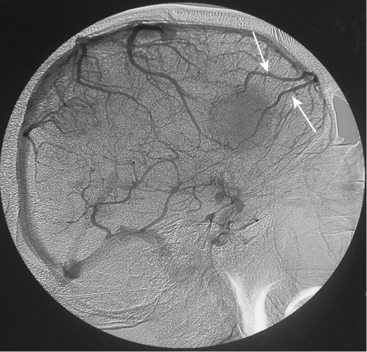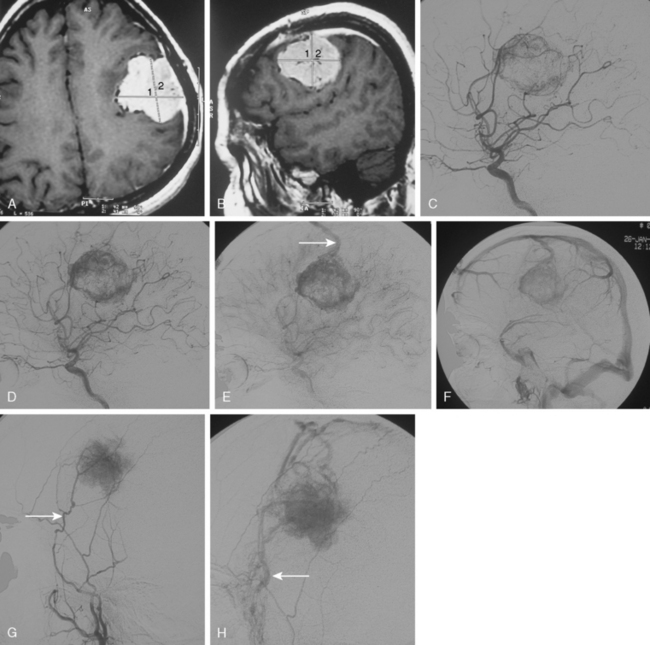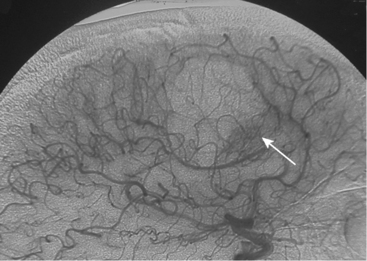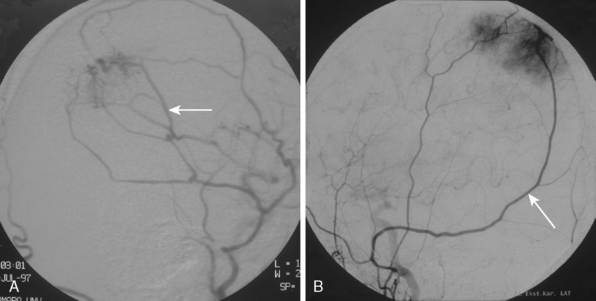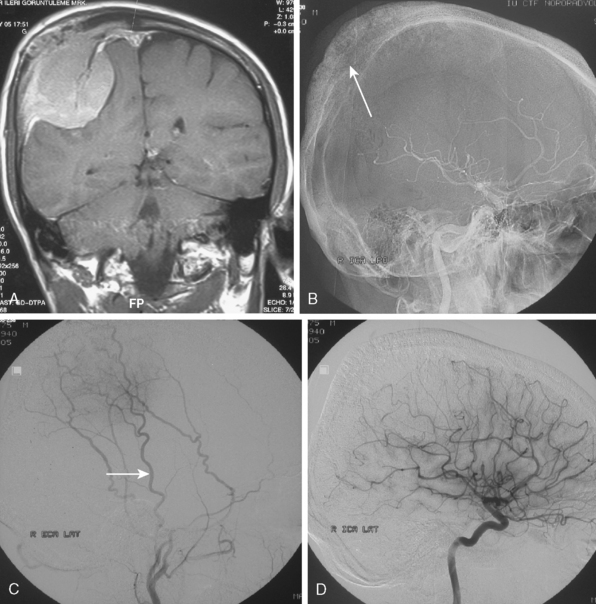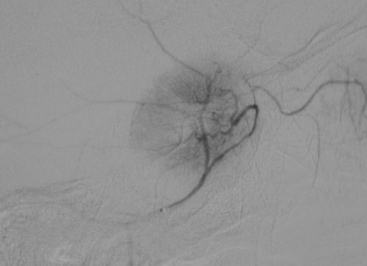CHAPTER 16 Angiographic Evaluation of Meningiomas
INTRODUCTION
For many decades, conventional cerebral angiography has been the major diagnostic modality to depict, diagnose, and investigate the specific features of all intracranial space-occupying lesions including meningiomas. Developed in the 1930s, angiographic technology has evolved considerably. The use of advanced technologies such as digital subtraction and three- dimensional image rendering, and the development of less toxic and better tolerated contrast materials, have greatly increased the diagnostic yield as well as the safety of angiography. Another major evolution in angiography technique has been the development of endovascular therapeutic techniques, which offer unique therapeutic possibilities. Advanced angiographic techniques and equipment have made this examination also more comfortable for the patient. Despite all of these advances, angiography is still an invasive technique that requires special skills and expertise, and one that is associated with a small but significant complication rate and radiation hazard risks. In the last four decades we have evidenced the development and widespread application of newer diagnostic technologies including computed tomography (CT) and magnetic resonance imaging (MRI). The diagnostic success of CT and MRI and their less invasive nature have greatly devaluated the importance of more invasive diagnostic modalities such as angiography, but not completely eliminated it. Newer technologies and modalities are still evolving to provide the information that can be gained from angiography. With the current technology, angiography still yields diagnostic information that CT or MRI cannot provide. Specific tumoral vessels are demonstrated in much better resolution than with alternative, less invasive techniques.1–3 However, angiography provides not merely a high-resolution map of the intracranial vasculature but also a detailed spatiotemporal analysis of the contrast material traveling through the vessels that yields important functional information on the tumor vasculature in addition to an anatomic description. Therefore, we believe that a good appreciation of angiographic technique and the information provided from it will lead to a better understanding of meningiomas. This chapter aims to summarize all available information on angiographic examination of meningiomas.
The major indication for cerebral angiography is the demonstration of the multiple feeding vessels of meningiomas, especially of the large ones, for which the possibility of preoperative embolization may also come into consideration.4 Further, meningiomas located in challenging operative areas or adjacent dural sinuses need to be subjected to meticulous angiographic examination.5 In this chapter the digital subtraction angiography (DSA) findings in meningiomas, such as typical angiographic features, feeding and adjacent arteries, dural sinus relationships, and special findings of meningiomas in certain localizations are presented.
ANGIOGRAPHIC TECHNIQUE
The indications for performing angiography in patients with meningiomas are far more limited and therefore much better defined today. Thus each angiographic examination is planned according to these needs and indications, considering the localization of the meningioma. A routine six-vessel examination may not be indicated or may not be sufficient, based on the requirements for the particular patient. A nonselective common carotid injection rarely provides sufficient information. Such a nonselective examination may fail to demonstrate the dural supply.6 A selective angiographic examination of the external carotid artery (ECA), the internal carotid artery (ICA), or the vertebrobasilar circulation is the method of choice. When preoperative embolization is planned, selective injection of all arteries, plus superselective examination of the tumoral vasculature, is required. The angiographic study should display both the tumoral vessels and the vascular anatomy of the related region. Venous phase examinations are important to study the condition of the adjacent veins and dural sinuses.7
ANGIOGRAPHIC FEATURES OF MENINGIOMAS
Tumors that have a rich vascular supply can be demonstrated angiographically. Historically, angiography had an important role in the differential diagnosis of intracranial tumors and differentiating benign meningiomas from malignant tumors such as gliomas and metastatic tumors. The most important evidence for such a differentiation was the speed of circulation through the tumor. Tumors with abnormal vascularity are divided into those with an increased speed of circulation through the tumor and those with a normal speed of circulation. An increased speed of circulation is almost invariably associated with a malignant histology. Few exceptions to this are angioblastic meningiomas and hemangioblastomas. Meningiomas may have a pathologically rich vascular tree and in some meningiomas the contrast circulation may be more rapid, and early draining, dilated veins may be observed (Fig. 16-1).8
TUMOR VASCULATURE
Meningiomas are extra-axial tumors that are based at the dura, and their vascular supply comes from normal arteries that supply the dura at the tumor’s site of attachment. Depending on the epicenter and the extent of meningiomas, these dural arteries may belong to the ECA, ICA, or the vertebrobasilar system.9 With increasing size, most meningiomas acquire blood supply from adjacent pial or leptomeningeal vessels (Fig. 16-2). The majority of meningiomas derive their vascular supply solely form the external carotid circulation. Another large proportion have suppliers from both the ECA and the ICA (or the vertebrobasilary system). Only a very small portion of meningiomas receive no vascular contribution from the ECA. Intraventricular meningiomas constitute fewer than 1% of all meningiomas. These are most commonly located at the atrium and are supplied by the hypertrophic anterior choroideal artery. The drainage is to the subependymal veins.10
The convexity dura and hence non–skull-base meningiomas are mainly fed by branches of the external carotid system. Such a predominantly external carotid arterial supply is a strong indication that the detected lesion is a meningioma. However; other tumors that invade the dura may also have a prominent ECA supply.11 In these instances, the fast circulation and the bone destruction induced by such malignant metastases or gliomas may aid in the diagnosis. Meningiomas, on the other hand, may cause bone destruction but predominantly with accompanying hyperostosis and thickening of bone. Angiographically occult or avascular meningiomas have also been reported.12 However, exclusion of an angiographic vascular supply requires the injection of all three vascular systems. Even if no specific filling is detected, an area of filling defect may be detected. In our series we have observed an avascular meningioma on a selective ICA catheterization (Fig. 16-3). In general, small, clinoidal, and en plaque meningiomas are the less vascular, whereas convexity and parasagital meningiomas are the more vascular varieties.
Parasagittal and convexity meningiomas can be the prototype to discuss the angiographic features of meningiomas. The convexity dura is supplied mainly by the middle meningeal artery (MMA), and this is the most common artery to be enlarged due to the increased vascular supply to a meningioma (Fig. 16-4).13 Convexity meningiomas derive their blood supply mostly from the MMA and accessory meningeal artery.14,15 At the midline location the vascular supply from the MMA may be bilateral. These tumors may frequently show invasion of the adjacent bone. Meningiomas that involve the adjacent bone may demonstrate perforating feeder branches from scalp vessels such as from the superficial temporal and external occipital arteries (Fig. 16-5). The blood flow in the ICA is comparatively faster than in the ECA. But the meningioma will result in earlier filling of the ECA branches, which is best appreciated on common carotid injections. The increased flow commonly results in a tortuous initial portion of the artery, before it bifurcates. Taveras and Wood have reported that such tortuosity may also be a normal variation, but that the persistence of this tortuosity in a segment longer than 1 to 2 cm is pathologic.16 Enlargement and earlier filling is also observed in branches of the middle meningeal trunk if they predominantly feed the tumor. Near its termination, the principal vessel feeding the meningioma will give off multiple radial vascular branches. This radial branching point is called the hilus and marks the epicenter of the tumor. In meningiomas that receive their vascular supply from both the ECA and ICA, the hilus is almost invariably fed by the ECA.16 In the early arterial phase, fine radially distributed tumor vessels become conspicuous, which is then followed by a “capillary blush.” The main feeder characteristically displays extensive branching at the hilus but the fine tumoral neovasculature displays linear centrifugal course without further branching (Fig. 16-6). This group of radially branching fine vessels is called the “sunburst pattern.”17 Frequently, the center of the sunburst pattern may correspond to a point of hyperostosis or osteolysis on the adjacent bone.18 This is characteristic of meningiomas but can also be seen in hemangiopericytomas. A fairly even distribution of the contrast material within the tumor in the capillary phase creates the characteristic capillary blush. Some meningiomas exhibit a more homogeneous blush in which vessels cannot be identified at all, probably due to their small size.19 In contrast to more invasive tumors such as gliomas, the capillary blush in meningiomas is sharply demarcated. In meningiomas that have a vascular supply from independent vessels originating from the ECA and ICA, the capillary blush may develop in a piecemeal fashion. The periphery of the tumor, especially of the large meningiomas, may be supplied by pial vessels that contribute to the gradual dense opacification of the meningioma (Figs. 16-7 and 16-8).13 The tumor blush continues to persist into the late venous phase, which is also a characteristic finding of meningiomas (see Fig. 16-1). Despite an abundant arterial supply and a well developed capillary tree, large and prominent venous structures are usually absent in meningiomas. In some meningiomas, venous drainage into the deep Galenic venous system may be observed.
The dural vascular supply is more complicated at the skull base, and most skull-base meningiomas have multiple suppliers. Tumors of the anterior fossa such as falx and olfactory groove meningiomas may derive their blood supply from the anterior meningeal artery, which is a branch of the anterior ethmoidal and respectively of the ophthalmic artery.20 Angiographic examination of midline anterior fossa tumors requires injection of both internal maxillary arteries. The dural branches of the ICA can supply the meningiomas extending more posteriorly. For midline tumors bilateral carotid examination is imperative to show a possible contralateral supply (Fig. 16-9). Middle fossa meningiomas such as those of the greater and lesser wings of the sphenoid bone are supplied by both the ECA and the ICA. Anastomotic connections between dural and pial vessels should also be considered.9 Examination of the arteries of the middle and anterior fossa meningiomas should systematically explore the origin of the ophthalmic artery, which is very variable. Middle fossa meningiomas can be supplied by the recurrent meningeal artery, which is a branch of the ophthalmic artery and/or small branches of the cavernous carotid artery. Meningiomas of the sellar and parasellar regions may be supplied by branches of the ECA such as the artery of foramen rotundum, the vidian artery, the accessory and MMAs, and the ascending pharyngeal artery. The tentorium is supplied mainly by the ICA.21 For meningiomas of the posterior fossa and the foramen magnum, catheterization of the ECA and its branch the ascending pharyngeal artery that supply the posterior fossa with the posterior meningeal artery is appropriate.22,23 However, the posterior meningeal artery can arise also as a branch of the middle meningeal or vertebral arteries and supplies the dura up to the falx cerebelli. Meningeal branches of the occipital artery supply the lateral regions of the posterior fossa. The anterior and inferior aspects of the clivus as well as the foramen magnum may derive their blood supply through the anterior meningeal branch of the vertebral artery. For clival meningiomas, bilateral injection of the ICA may be necessary because of contributions from both cavernous ICA segments. Cerebellopontine angle meningiomas may be supplied by the dural branches of the MMAs but may also receive a contribution from the branches of the ascending pharyngeal and occipital arteries. Examination of this area may be improved by superselective catheterization of these arteries.

